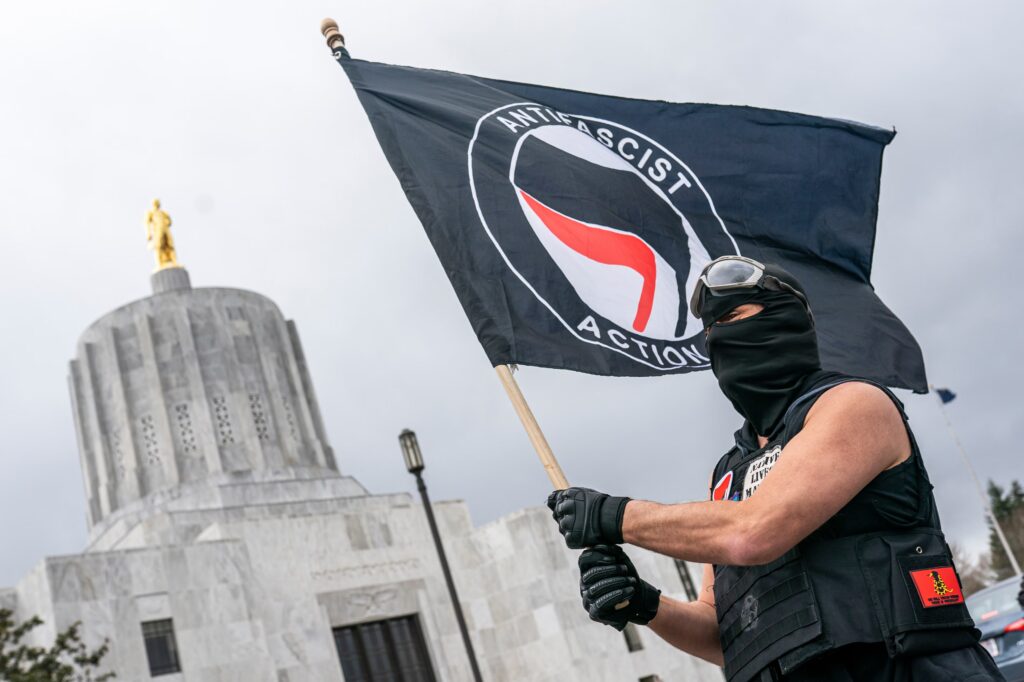With his order, Trump is delivering red meat to his base after years of drumming up fears around left-wing activism, which his administration has characterized as a dangerous scourge.
Following the murder of right-wing commentator Charlie Kirk at a speaking event in Utah earlier this month, Trump and his allies vowed an aggressive crackdown on leftists, despite the fact that prosecutors are yet to surface any evidence that the shooter was aligned with far-left groups.
In his order, Trump describes antifa as a “militarist, anarchist enterprise that explicitly calls for the overthrow of the United States Government, law enforcement authorities, and our system of law”. In a statement he called it a “SICK, DANGEROUS RADICAL LEFT DISASTER.”
The order and an accompanying “fact sheet” states that antifa’s “campaign of violence and terrorism nationwide” includes doxing of “political figures and activists”, assaults against Ice officers and organized riots. The designation was met with immediate concern online by activists and civil liberties experts that it could be used to broadly suppress and criminalize first amendment activity such as protests against Ice activity.
Fears that such a designation could be applied broadly are rooted in the fact that there is no such formal entity called antifa.
Antifa is the organizing principle behind a loose nationwide network of local chapters of far-left activists. It has no command structure or leadership, but has remained a favorite boogeyman to describe a grab bag of left–wing activism. Though the activities of antifascist organizations vary according to chapters and geographical location, they became best known for “black bloc” counterprotest tactics in opposition to far-right demonstrations, particularly those led by the Proud Boys, during Trump’s first administration.
Kirk’s death on 10 September unleashed a torrent of heavy-handed rhetoric and threats from Trump and his allies against the left. In a post on X, Stephen Miller, the White House deputy chief of staff, took aim at an ideology that “celebrates everything that is warped, twisted and depraved”, whose “one unifying threat is the insatiable thirst for destruction”. Trump said he’d spoken to Pam Bondi, the attorney general, about exploring Rico charges against left-wing activists.
“They should be put in jail, what they’re doing to this country is really subversive,” he said in the Oval Office earlier this month.
Though political violence across the spectrum has been on the rise, data does not support the Trump administration’s portrait of an unchecked violent threat from the far-left. Data does show that attacks by right-wing extremists are often far deadlier. There have been 391 deaths caused by right-wing attacks in the US since 1975, compared to 65 deaths from left-wing attacks, according to the Cato Institute, a libertarian think-tank.
The last decade in the US has seen a steady drumbeat of mass murders by white supremacists who were radicalized by anti-immigrant ideology, including the 2018 shooting at a synagogue in Pittsburgh, the 2019 shooting at a Walmart in El Paso, Texas that targeted Latinos, the 2022 shooting at a supermarket in Buffalo, New York targeting Black people. These are facts that may be inconvenient to the Trump administration’s narrative pretext for its crackdown against leftists.
Days after Kirk’s shooting, the Department of Justice quietly scrubbed a now-archived report from its website finding that far-right extremists have killed more Americans than any other domestic terrorist group.
What Trump’s executive order will actually mean in practice is not entirely clear. It directs “all relative executive departments and agencies” to utilize “all applicable authorities to investigate, disrupt, and dismantle any and all illegal operations – especially those involving terrorist actions – conducted by Antifa or any person claiming to act on behalf of Antifa, or for which Antifa or any person claiming to act on behalf of Antifa provided material support”.
There is no federal domestic terrorism statute in the US. Much of the modern counterterrorism infrastructure was created in the aftermath of 9/11 to combat the threat posed by foreign terror groups.
Although the 2001 Patriot Act does offer a legal definition of domestic terrorism, there is no associated crime in the federal penal code, though federal prosecutors can bring domestic terrorism charges in a handful of narrow circumstances and US sentencing guidelines provide for terrorism enhancement.
Some counterterrorism experts have pushed for the creation of a domestic terror law in recent years, arguing that it would lend moral equivalence between attacks by white supremacists and those committed by Islamist extremists. Those efforts were met with concerns by civil liberties experts that such a law, in the wrong hands, could lead to its weaponization.
______________________________________________
Tess Owen is a freelance reporter covering extremism, disinformation, politics and more.
